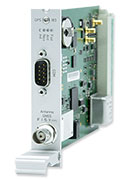TTL Signal
TTL stands for transistor-transistor logic, a digital circuit that uses transistors to switch between two voltage levels representing logic 0 and 1. A TTL signal is a digital signal that meets the specifications of TTL logic.
In a TTL circuit, logic 0 is usually represented by a voltage close to 0 volts, while logic 1 is represented by a voltage close to 5 volts. The actual voltage levels depend on the specific implementation of the TTL circuit. These levels are standardised to ensure compatibility between different TTL circuits.
TTL signals are commonly used in digital circuits and systems. They are widely used in electronics because they have low power consumption, high noise immunity and fast switching speeds.
Back to glossary
Featured Products:

Redundant GPS-synchronized Time and Frequency Reference in 1U Housing
Read More...
High-Performance Antenna Engineered for Time, Frequency, and Phase Synchronization
Read More...
Clock Module with GPS Satellite Receiver
Read More...
DCF77 radio clock with serial RS232 interface
Read More...


